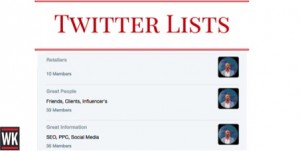The best social media outlets are the one your customers use. Learn how to find them and build engagement via today’s popular platforms.
Traditional word of mouth, with one person talking to another, only goes so far in today’s business world. Thankfully, word of mouth has gone online with social media, and now one person can share his thoughts and opinions with potentially millions of others.
You can harness that reach for your business, but first, you need to consider two things:
- Whom do you want to reach?
- What do you want to accomplish?
You want to build mutually beneficial relationships that will help both your business and your key audiences, which include existing customers, potential customers, vendors, industry colleagues and more.
Social media can do that.
How to find your audience on social media
According to the Pew Research Center, approximately 74 percent of Internet users use some sort of social media. This means three-fourths of Web surfers maintain at least one account; more than half maintain accounts on multiple platforms.
Those people belong to your key audiences.
It’s important to start out by doing a little research on what social media your key audiences use and then setting up your accounts on those outlets. For example, if your target group is teenagers, it won’t do any good to promote your content on LinkedIn, a site for professional adults. You’d want to think about Twitter and Instagram, the platforms teens are most likely to use.
Each platform reaches its own unique demographic groups:

How to use social media to accomplish your goals: the pros and cons of the major platforms
![]() In addition to having differing demographics, social media platforms also have different strengths and weaknesses that can help you accomplish or hinder your goals. Let’s look at the big at four of the platforms most used by businesses – Facebook, Twitter, Pinterest and Instagram.
In addition to having differing demographics, social media platforms also have different strengths and weaknesses that can help you accomplish or hinder your goals. Let’s look at the big at four of the platforms most used by businesses – Facebook, Twitter, Pinterest and Instagram.
Strengths:
With a strong 71 percent of all Internet users onboard, Facebook remains the go-to platform for many.
It has user- friendly analytics tools that track things such as comments, shares, likes, followers and user demographics. The platform also has great administrative tools that allow you to monitor feedback, target specific groups, run advertisements and more.
Kelly Lester, the entrepreneur behind Easy Lunch Boxes, uses Facebook’s features to share photos, videos and food tips with folks who have to pack meals. The Facebook page also provides meal ideas, questions and answers, an opportunity to purchase Lester’s products, and regular feedback to visitors’ comments.
Weaknesses:
Facebook is constantly tweaking its algorithm, which determines what items show up in a person’s news feed. If you set up a business page, followers will not see everything you post. According to Ad Week, the average reach of a Facebook post is only 2.6 percent. To increase that reach, you’ll have to purchase advertising to promote your posts. To be fair, the rates aren’t bad, and Facebook’s program gives you the ability to target very specific groups, who may or may not already follow you.
Strengths:
A user-friendly interface and high level of interaction makes Twitter very popular among teens and young adults. Messages, called tweets, are limited to 140-characters, which means your content has to be short, sweet and to the point. It’s a great outlet for businesses that need to share time-sensitive information with their key audiences.
Twitter is one of the few searchable social media platforms, thanks to its use of hashtags (#). Hashtags create searchable links and make it easy to follow popular trends. Creative organizations can even create their own hashtags and gain followers and engagement. For example, Coca-Cola got customers to share their stories via #ShareACoke. The Make-A-Wish Foundation used #BatKid to help a 5-year-old cancer fighter become a San Francisco super hero thanks to the help of 16,000 actors and volunteers. Their tweets reached more than 545,576 people in just three days.
Weaknesses:
Twitter is definitely for text-based messages, and it is less image-friendly than other platforms. The Twitterverse is also huge and fast-paced. Your tweets could get lost, especially if your followers are following several other accounts. Because of Twitter’s speed and reach, it can be very difficult to control should something negative come up about your business. When McDonald’s tried to spread the word about its redesigned Ronald McDonald clown mascot, nearly all of the responses bashed the change and criticized their food. Oops.
Strengths:
Pinterest is a visual bookmarking tool that helps users find and save creative ideas. Users can save content from other sites to their own personal virtual bulletin boards. This saved content, called pins, links back to the site it came from.
Pinterest boasts 28 percent of Internet users, predominately female, and remains the strongest visually-based platform. You can use it for your business by creating your own board and offering pins for others to re-pin and share. In the interest of etiquette, you should also re-pin and share content from other boards as well.
Pinterest still remains relatively underutilized for business use, but small businesses such as Artifact Uprising show how Pinterest can make a huge difference. The basement startup became a multi-million company within 18 months after one of their pins took off.
Weaknesses:
Image quality is critical. Your business will need to invest in photography and graphic design to create high-quality, unique images to share on the site. Since the platform doesn’t allow users to leave comments, it can be also difficult to create engagement and build relationships.
Strengths:
Instagram has the highest engagement and conversion from browser to shopper. At 26 percent of Internet users, Instagram transitioned from a mobile app to a recognized and powerful platform, especially among millennials. Like Pinterest, Instagram is also underutilized by businesses; however, those who have harnessed its reach have enjoyed success. Cosmetics company Lancôme asked women to post Instagram photos of themselves without make-up for its #bareselfie campaign. The campaign generated half of all sales for one of its skin serums.
Weaknesses:
Like Pinterest, Instagram relies on good images, which can require an investment in visual production. The platform does not offer an ability to click on URLs or links in captions and comments, which can make it difficult to drive traffic to your website. Instagram is further limited in that images can be shared or posted only from mobile devices.
Conclusion: Put it all together
While it may seem appealing to operate from a single platform, especially for time considerations, you could severely hamper your reach. Don’t limit your business to just one. Do some research on your key audiences, find out what platforms they use, and then start creating and sharing content on those platforms.
Here’s how it can work:
Let’s say you run a small hotel and want to reach families planning their summer vacations.
- You can write a blog post about tips for hassle-free family travel that includes information about must-haves related to lodging – and surprise, your hotel just happens to offer some of those must-have features.
- Share your blog post via Facebook and ask readers to comment about what other tips they’d offer for family travel.
- While Twitter would not be a primary platform for your campaign, it wouldn’t hurt to tweet out your vacation tips article with a #FamilyVacation message. Some of your families may be headed by young adults.
- To reach more of the moms, use some of the photos you featured in your post and pin them on your Pinterest board. Add a few other family-vacation related pins from other sources, too.
- You also want to reach the teenagers, so use your business Instagram page to highlight some images of teen-friendly attractions near your hotel. You can tie the whole family back together by also asking people to share their own summer vacation photos on your site.
What’s the best social media outlet for your business?
As demonstrated above, all the ones your key audience uses.
Digital & Social Articles on Business 2 Community(78)





